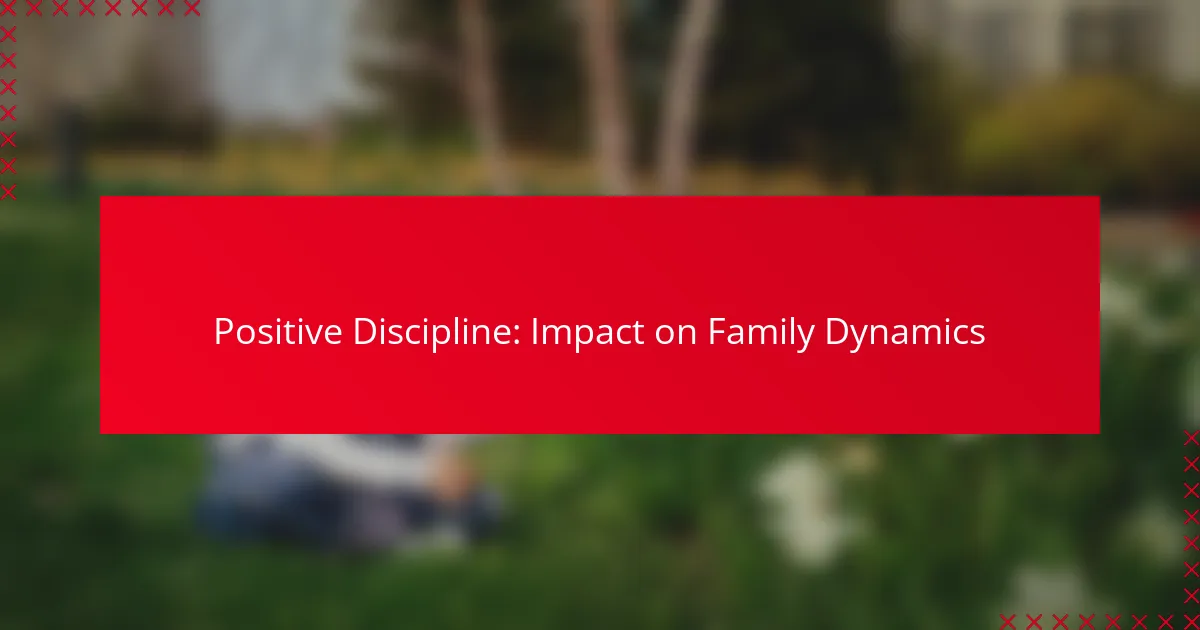Positive Discipline significantly enhances family dynamics by fostering respectful interactions and effective communication among all members. This approach not only teaches children self-discipline and responsibility but also creates a supportive environment where emotions are understood and essential life skills are developed.
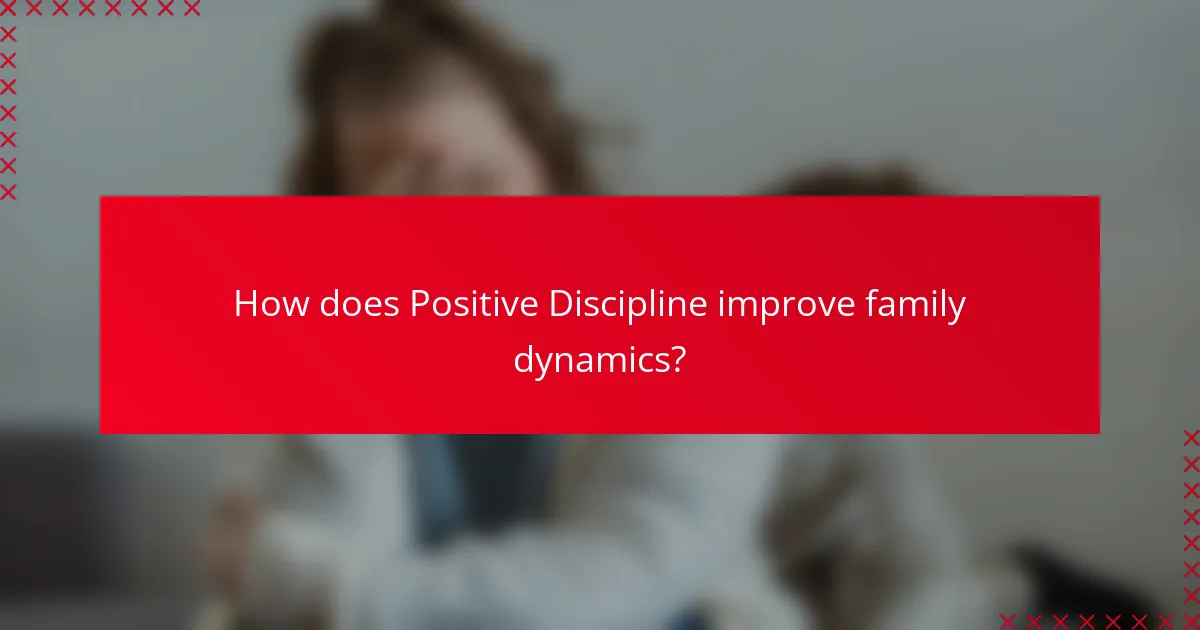
How does Positive Discipline improve family dynamics?
Positive Discipline enhances family dynamics by promoting respectful interactions and effective communication among family members. This approach fosters a supportive environment where children learn to understand their emotions and develop essential life skills.
Enhances communication skills
Positive Discipline encourages open dialogue within the family, allowing members to express their thoughts and feelings freely. By using “I” statements and active listening, families can address conflicts constructively and reduce misunderstandings.
For example, a parent might say, “I feel worried when you don’t come home on time,” rather than blaming the child. This method fosters a more empathetic atmosphere, leading to improved relationships.
Fosters mutual respect
This approach emphasizes the importance of treating each family member with dignity. By setting clear expectations and boundaries, families can create a culture of respect where everyone’s opinions are valued.
Practicing mutual respect can involve simple actions like acknowledging each other’s contributions during family meetings or celebrating individual achievements, which strengthens bonds and promotes cooperation.
Encourages emotional regulation
Positive Discipline teaches family members to recognize and manage their emotions effectively. By modeling emotional regulation, parents can help children learn how to cope with frustration, anger, or sadness in healthy ways.
Techniques such as deep breathing, taking a timeout, or discussing feelings can be integrated into daily routines, providing children with tools to navigate their emotions and reducing family conflicts.
Builds problem-solving abilities
This discipline method encourages families to work together to find solutions to challenges. By involving children in the problem-solving process, they learn critical thinking and negotiation skills that are essential for their development.
For instance, when facing a household issue, families can brainstorm possible solutions together, weighing the pros and cons of each option. This collaborative approach not only resolves conflicts but also empowers children to take responsibility for their actions.
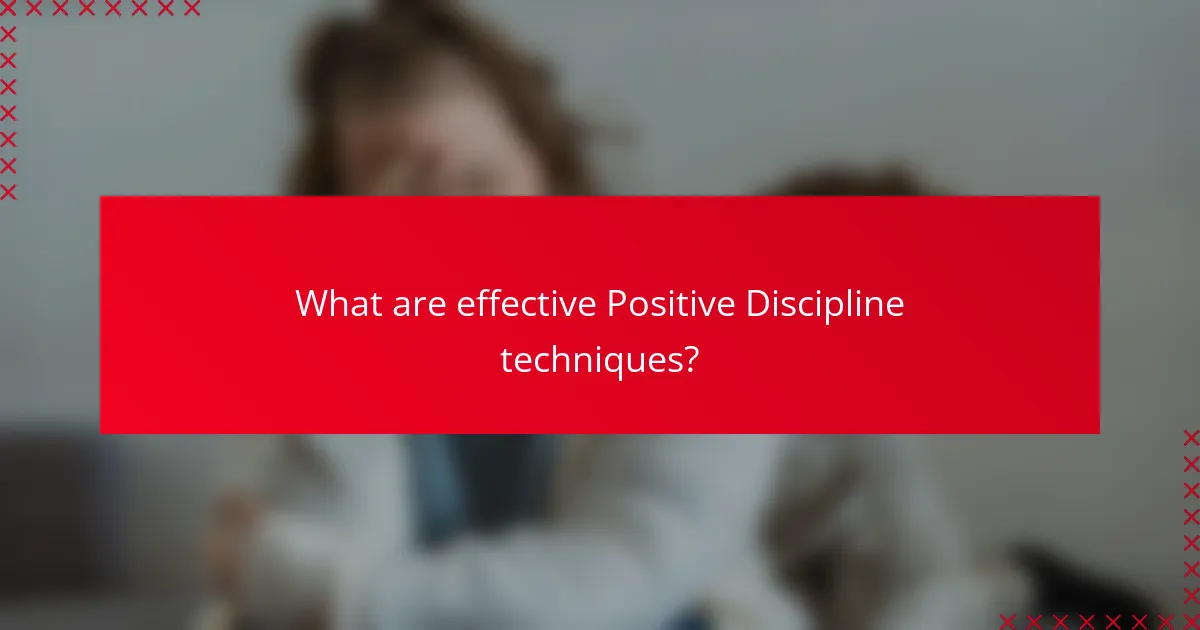
What are effective Positive Discipline techniques?
Effective Positive Discipline techniques focus on teaching children self-discipline and responsibility while fostering a supportive family environment. These methods emphasize understanding the reasons behind behavior and promoting constructive communication.
Time-outs as reflection opportunities
Time-outs can serve as valuable moments for children to reflect on their actions rather than simply being a punishment. During a time-out, children are encouraged to calm down and think about what they did and how it affected others.
To implement effective time-outs, choose a quiet space free from distractions. Keep the duration age-appropriate, typically one minute for each year of the child’s age. After the time-out, engage in a discussion to reinforce learning and understanding.
Natural consequences for actions
Natural consequences occur when children experience the direct results of their actions, helping them learn responsibility. For instance, if a child refuses to wear a coat on a chilly day, they will feel cold, which teaches them to make better choices in the future.
When applying natural consequences, ensure they are safe and appropriate. Avoid using them as a form of punishment; instead, frame them as learning experiences. This method encourages children to think critically about their decisions and the impact on themselves and others.
Family meetings for collaborative problem-solving
Family meetings provide a platform for open communication and collaborative problem-solving, allowing everyone to voice their opinions and contribute to solutions. These gatherings can help address issues collectively, fostering a sense of teamwork and unity.
To conduct effective family meetings, set a regular schedule and create a welcoming environment. Encourage each family member to share their thoughts and feelings. Use this time to brainstorm solutions together, ensuring that everyone feels heard and valued.
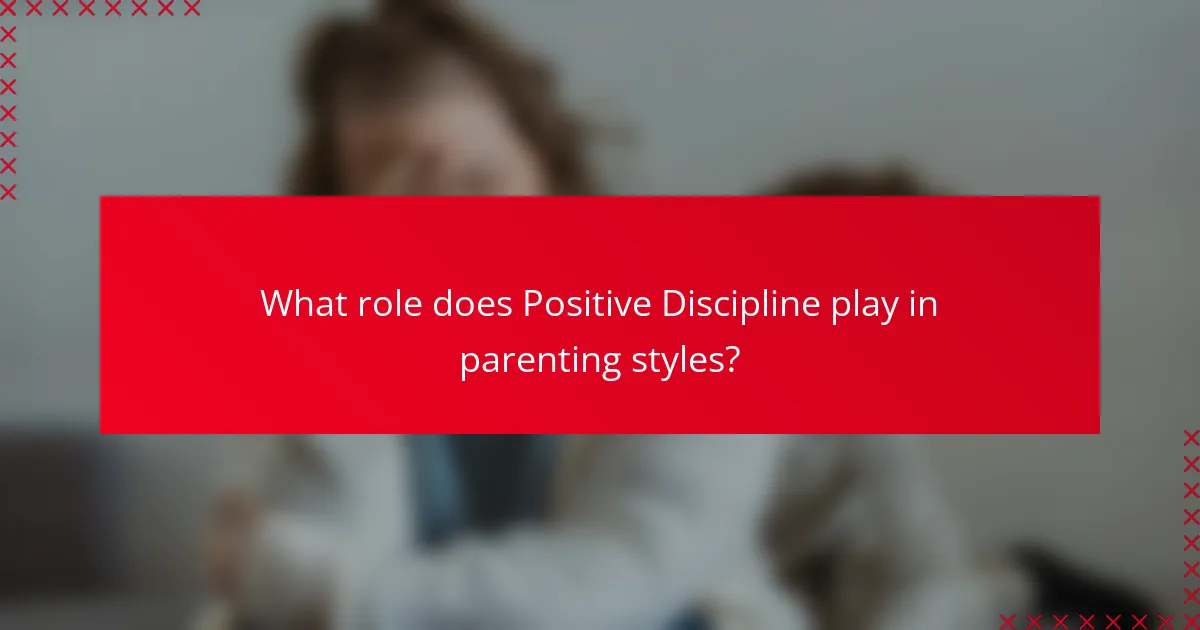
What role does Positive Discipline play in parenting styles?
Positive Discipline is a parenting approach that emphasizes respect, encouragement, and understanding while guiding children toward self-discipline. It fosters a cooperative family dynamic by promoting effective communication and problem-solving skills.
Supports authoritative parenting
Positive Discipline aligns closely with authoritative parenting, which balances high expectations with emotional support. This style encourages parents to set clear boundaries while also being responsive to their children’s needs, fostering a sense of security and autonomy.
Parents can implement Positive Discipline by using techniques such as active listening and collaborative problem-solving. For instance, instead of issuing commands, parents might ask their children for input on resolving conflicts, which strengthens their relationship and builds trust.
Differentiates from authoritarian methods
Unlike authoritarian parenting, which relies on strict rules and punishment, Positive Discipline focuses on teaching rather than controlling. This approach encourages children to understand the reasons behind rules and the consequences of their actions, promoting intrinsic motivation.
For example, instead of punishing a child for misbehavior, a parent might explain the impact of their actions and work together to find a better solution. This method helps children develop critical thinking and emotional intelligence, essential skills for their future.
Promotes nurturing environments
Positive Discipline fosters nurturing environments by prioritizing empathy and respect in parent-child interactions. This approach encourages parents to validate their children’s feelings while guiding them through challenges, creating a safe space for emotional expression.
To cultivate a nurturing atmosphere, parents can practice positive reinforcement, such as praising effort and progress rather than just outcomes. This not only boosts children’s self-esteem but also encourages a growth mindset, where they feel empowered to learn from mistakes.
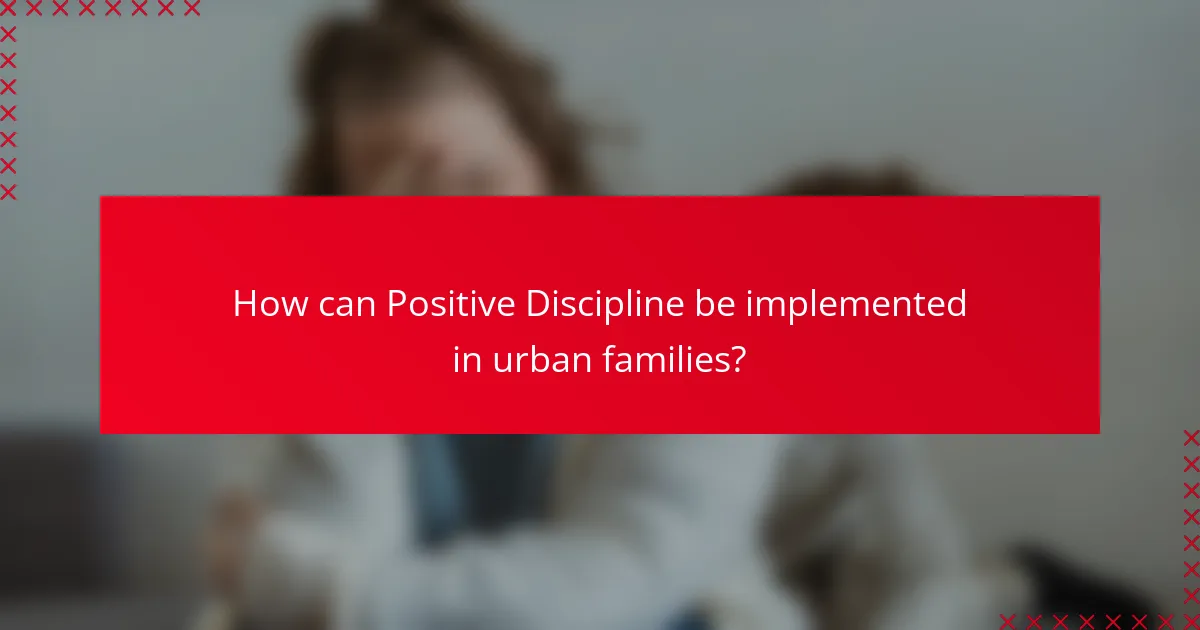
How can Positive Discipline be implemented in urban families?
Positive Discipline can be effectively implemented in urban families by fostering respectful communication and setting clear expectations. Families can utilize community resources and online platforms to learn and practice these techniques in their daily lives.
Community workshops in major cities
Community workshops in urban areas provide parents with hands-on training in Positive Discipline techniques. These workshops often feature experienced facilitators who guide families through role-playing scenarios and group discussions, making the learning process interactive and practical.
Many cities offer these workshops at local community centers or schools, sometimes at little to no cost. Parents can check local listings or community boards for upcoming events, ensuring they find sessions that fit their schedules.
Online resources for busy parents
For busy urban parents, online resources such as webinars, e-books, and instructional videos can be invaluable. These platforms allow parents to learn at their own pace and revisit materials as needed, making it easier to integrate Positive Discipline into their routines.
Websites and apps dedicated to parenting often feature articles and forums where parents can share experiences and strategies. Utilizing these resources can help families stay informed about the latest techniques and best practices in Positive Discipline.
Support groups for shared experiences
Support groups provide a space for urban families to share their experiences and challenges with Positive Discipline. These groups can be found through local parenting organizations or online platforms, offering both in-person and virtual meetings.
Participating in a support group allows parents to gain insights from others facing similar situations, fostering a sense of community. Parents can exchange tips, discuss obstacles, and celebrate successes, which can enhance their commitment to Positive Discipline practices.
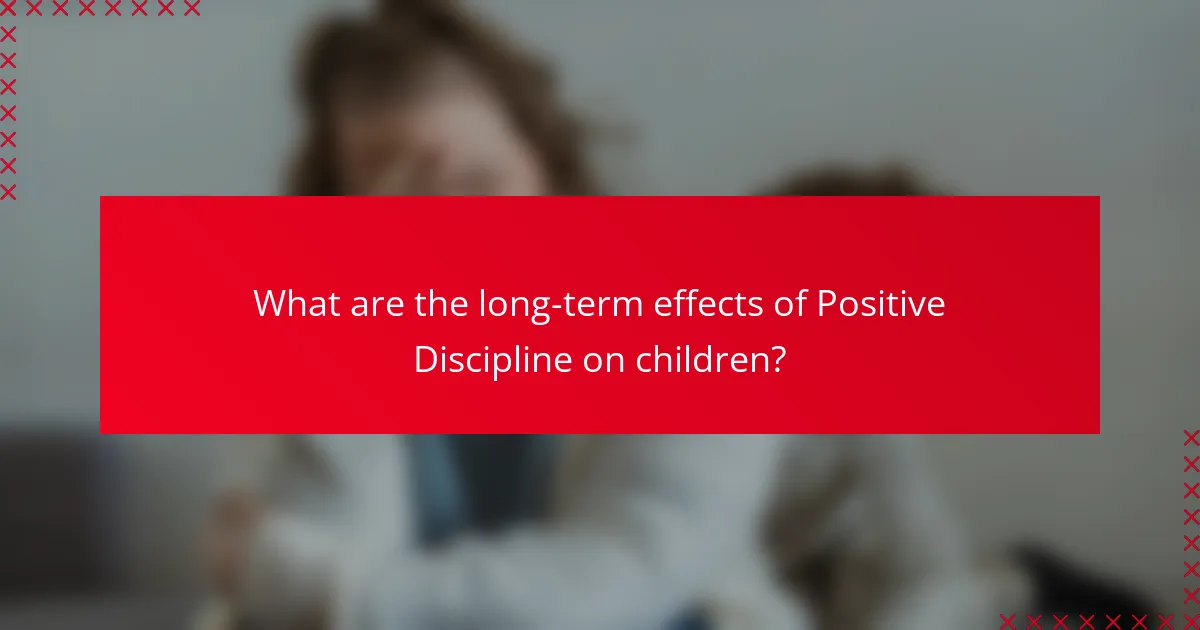
What are the long-term effects of Positive Discipline on children?
Positive Discipline fosters a nurturing environment that can lead to significant long-term benefits for children. These effects include enhanced academic performance, improved social skills, and a reduction in behavioral issues, all contributing to healthier family dynamics.
Improved academic performance
Children who experience Positive Discipline often show better academic outcomes. This approach encourages a love for learning by promoting intrinsic motivation rather than fear of punishment. As a result, children tend to engage more actively in their education, leading to higher grades and a greater likelihood of pursuing higher education.
For example, students who feel supported and understood are more likely to participate in class discussions and seek help when needed. This proactive engagement can translate into improved test scores and overall academic success.
Better social skills
Positive Discipline helps children develop essential social skills, such as empathy, cooperation, and effective communication. By modeling respectful interactions and encouraging children to express their feelings, families create a foundation for healthy relationships.
Children learn to navigate social situations more effectively, which can lead to lasting friendships and a supportive peer network. Skills gained through Positive Discipline can also enhance conflict resolution abilities, allowing children to handle disagreements constructively.
Lower rates of behavioral issues
Implementing Positive Discipline can significantly decrease behavioral problems in children. This method focuses on teaching rather than punishing, which helps children understand the consequences of their actions without resorting to fear-based tactics.
Research indicates that children raised with Positive Discipline techniques exhibit fewer instances of aggression and defiance. Parents can reinforce this by consistently applying these principles, creating a stable environment where children feel secure and understood, ultimately leading to better behavior.
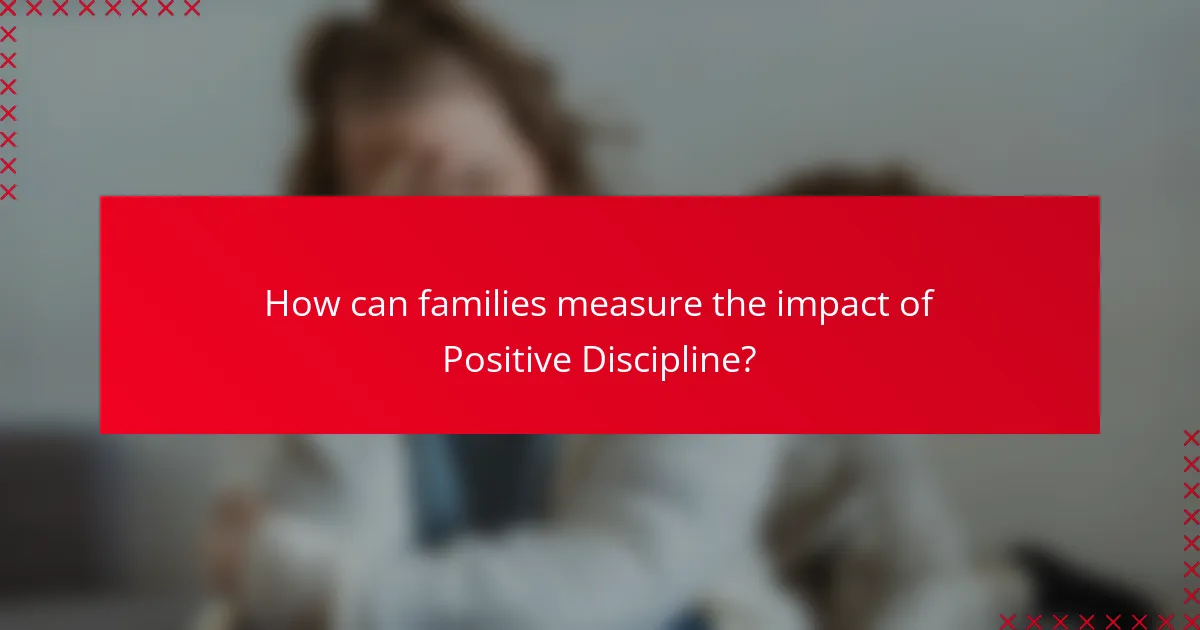
How can families measure the impact of Positive Discipline?
Families can measure the impact of Positive Discipline by observing changes in behavior, communication, and emotional well-being among family members. Tracking these changes over time can provide insights into the effectiveness of the approach.
Behavioral Changes
One of the most noticeable impacts of Positive Discipline is the improvement in children’s behavior. Families can assess this by keeping a record of specific behaviors before and after implementing Positive Discipline techniques. For example, a reduction in tantrums or increased cooperation during chores can be indicators of success.
Additionally, families can use simple rating scales to evaluate behavior changes weekly or monthly. This could involve rating cooperation, respect, or conflict resolution on a scale from 1 to 5, allowing for easy tracking of progress over time.
Communication Improvements
Positive Discipline fosters open and respectful communication within families. To measure this impact, families can observe the frequency and quality of discussions. Are family members expressing their feelings more openly? Are conflicts being resolved more constructively?
Conducting regular family meetings can also help gauge communication effectiveness. During these meetings, families can discuss what is working well and what needs improvement, providing a platform for everyone to share their thoughts.
Emotional Well-Being
The emotional health of family members is another critical area to assess. Families can measure emotional well-being by checking in with each other about feelings and stress levels. Simple tools like mood charts can help track changes over time.
Moreover, families might consider using anonymous surveys to gather honest feedback about emotional safety and support within the household. This can provide valuable insights into how Positive Discipline is influencing family dynamics.
